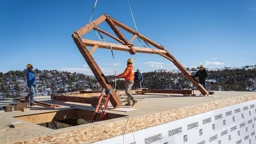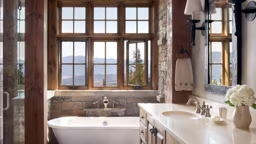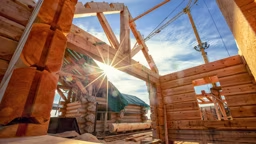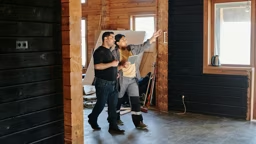
Plans and Photos: Courtesy of Riverbend Timber Framing
If you’ve followed the past three installments of this series, you’ve learned that Riverbend Timber Framing has designed a home for a Marysville, Ohio, family who need plenty of space to accommodate their extended family (and favorite furniture pieces) and that specialty fabrication techniques have contributed to the home’s ultimate aesthetic. Now, it’s time to build the house — and get the Riverbend stamp of approval.
Inspection 1:
The Foundation
There was snow on the ground when the first load of fabricated timbers arrived at the job site. For eight weeks, the builder prepared for their arrival by excavating the earth, pouring the foundational slab and completing the floor deck. The team worked to lay a strong foundation for the home, knowing an inspection by Riverbend‘s project manager Eric Dempsey was imminent. In fact, the tale of raising this getaway is the story of three inspections, all performed or coordinated by Eric.
Inspection 2:
The Structural Shell
With the foundation approved, Riverbend’s team of installers arrives to begin erecting the timber frame. After being assembled on the ground, the bents are raised into place with a crane and joined with 7-by-11-inch ridge timbers. During this step, bundles of scattered materials transform into a recognizable frame. “Everything falls into place, one by one,” says Eric, “until the timbers are able to stand on their own.”
Once the 6-and-1/2-inch wall and 10-and-1/4-inch roof structural insulated panels (SIPs) manufactured by Insulspan and windows are installed, it’s time for Eric’s structural inspection. (After the drywall is up, there’s no way to tell if the structure of the home is accurately built.) It’s critical that every aspect of the build adheres to the construction plan and that each detail, from load-bearing points to duct work and roof seams, is solid.
Beyond structural necessities, it’s the finishing touches that make a house a home. Stone surrounds the front door, support piers and an outdoor fireplace in the rear patio (which serves as the home’s real entrance). The bathrooms are tiled, while the common area, which is built to accommodate a bar and pool table, is lined with wide-plank hardwood floors.

Once the frame is enclosed and weather tight, a blower-door test identifies areas where seals are compromised and may leak so the crew can address them.
Inspection 3:
Energy Audit
Once the finishing details are complete, Eric oversees the final inspection: an energy audit to verify the home’s airtightness. During the process, a blower door fan is used to depressurize the home. Since air naturally moves to equalize pressure differences, the tester applies a consistent and measurable pressure to get an accurate reading of the air changes per hour. In addition, thermal imaging of the home is completed to identify areas of leakage. The energy auditor and Eric declared the structure of this home “nice and tight.”
While the owners wanted their home ready as soon as possible, building a timber home is a slow-and-steady, measure-twice-cut-once process. “From start to completion, the project took around 12 months,” Eric says.
From the Riverbend Timber Framing team to Nicholson Builders to the Marysville neighbors who allowed construction equipment to be stored on their property, there were countless people involved in the raising of this home. “That’s the story of timber framing for ever and ever,” says Riverbend’s marketing manager Laura Jamison. “It’s always a community effort.”
Home Details
Square footage: 2,725
Bedrooms: 2
Bathrooms: 2











